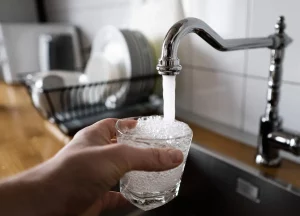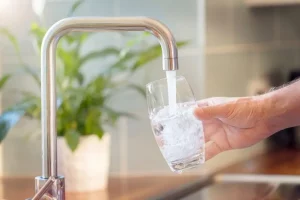Although they are not allowed to be inhaled through water, the chloramines can cause severe irritations and corrosive effects.
These are some of the major disadvantages to using chloramine to disinfect water.
* Inflames the Eyes and Skin
Chloramine in water can cause skin irritations and skin problems. Chloramine-treated water can lead to severe rash outbreaks in sensitive skin. These can aggravate skin conditions such as eczema or acne. Chloramines can cause skin flakiness, dryness, scaliness and outbreaks. People can experience stinging, red eyes, mucus membrane problems, sinus problems, and issues with their nasal passages and mucus membranes. You are inhaling chloramine in enclosed spaces, such as a shower stall. This can cause severe discomfort for people who are sensitive to chloramine.
* Harsh taste and odor
Although not as harsh as chlorine chloramine can leave water with a metallic taste or tangy chemical aftertaste. It can also leave water with a distinctive “pool” smell.
* May cause kidney dialysis patients to become more severe
By contaminating dialysis fluids and entering dialysis patients’ blood, chloramine can cause kidney dialysis patients to become ill. Chloramines can cause hemoglobin to be altered, which can lead to a potentially fatal condition called “hemolyticanemia”.
* Toxic to aquatic plants and animals
Keep your aquarium clean and free from chloramine. Aquatic creatures like fish, amphibians and water-based reptiles are extremely sensitive to chloramines. These animals can be killed if they are exposed to chloramine via their gills and skin. The chemical can also cause harm to humans and other animals who eat the contaminated fish or aquatic animals. The chemical chloramine can cause damage to plants and alter their delicate nutrient balance.
* Corrodes Metal Pipes and Solders
One example of the indirect effects of chloramine is when a water system switches from a chlorine-based system to a chloramine-based one in order to comply with DBP regulations. The municipality must then increase the pipe corrosion inhibitor in order to stop chloramine from altering water chemical and causing lead or copper leaching into the water.
Washington, D.C. did not consider this when it switched to a chloramine-based system early 2000s. The resulting contamination caused water lead levels to rise throughout the city. This led to a five year lead contamination crisis in which more than 42,000 children below two were exposed to high levels of lead.
We have already discussed how lead in drinking water affects children and adults in How Lead in Drinking Water Affects Kids and Adults. Children can experience behavioral changes such as decreased attention spans and antisocial behavior. Attention problems, cognitive dysfunction, learning disabilities, hearing loss, low I.Q. and hearing loss are some of the other common symptoms. Lead poisoning can also cause physical impairment (decreased bone, muscle growth), anemia, hypertension, damage to the liver, kidneys and reproductive organs, as well as lead poisoning. In rare cases, lead poisoning can cause seizures, comas, or even death. Children may experience headaches, weight loss, nausea, vomiting, muscle and joint weakness, as well as loss of appetite and weight loss.
Lead’s potentially dangerous effects on the health of adults is also a concern for them. Adults may experience anemia, high blood pressure, constipation, mood disorders, and abdominal pain. It can also lead to decreased sperm quality and quantity, memory loss, decline in mental functions, difficulty falling asleep, pain and numbness, and other symptoms such as hallucinations and headaches. Low fertility, gout and carpal tunnel syndrome may occur in some adults.
Chloramine in drinking water can also cause copper contamination. Copper contamination is more common in drinking water if it is leaked from plumbing fixtures, solders and pipes. Too much copper can lead to nausea, vomiting, dizziness, stomach discomfort, and even death. Liver toxicity, heart problems and even death are more severe symptoms.
* Copper Pipe Leakages
Copper pipes are not compatible with chloramine. Chloramine-treated water may alter the water’s chemical characteristics, which together with lower pH, alkalinity, and nitrification can lead to corroded copper pipe. Copper plumbing can cause pinhole leaks if left unattended. These can often be concealed and homeowners may not be aware of the damage until it is too late. Pinhole leaks can lead to mold growth, which can be very toxic and often permanent. Pinholes can also leak dirt, sand and silt into your drinking water.
* Deteriorates Rubber
Chloramine is not only destructive to copper and lead pipes but also eats rubber plumping parts like rubber flappers and rubber casings. When black specks are found in the water from plumbing components, this is a sign of corrosion. These bits of rubber can cause serious health problems if they are ingested and build up over time.
* Nitrification
Sometimes, ammonia found in chloramines can be oxidized and transformed into nitrates by nitrification. Although nitrates are not harmful in small amounts, they can cause microbial growth to be inhibited, which could lead to pathogens entering your drinking water supply. If the chloramine levels aren’t monitored and adjusted, you run the risk of getting waterborne diseases.
Is Chloramines safe to drink?
Chloramines don’t pose a danger to health. According to the U.S. Environmental Protection Agency, chloramines are not a health hazard. Water containing chloramines that meets the EPA regulatory standard (up to 4 mg/L) is safe to drink, cook, bathe, and for other household purposes. Research has shown that drinking water containing 4 mg/L chloramines is not associated with any health problems or long-term effects. Public water providers are required to follow strict guidelines when distributing water. This means that they will not be exposed to water containing more than 4 mg/L chloramine. Hemodialysis patients are an exception to this rule as chloramines can get into their bloodstream through the dialysis membrane. You should still remove chloramine from your water supply completely, given the potential health effects it can have on humans, aquatic animals, pipes, and plumbing.











